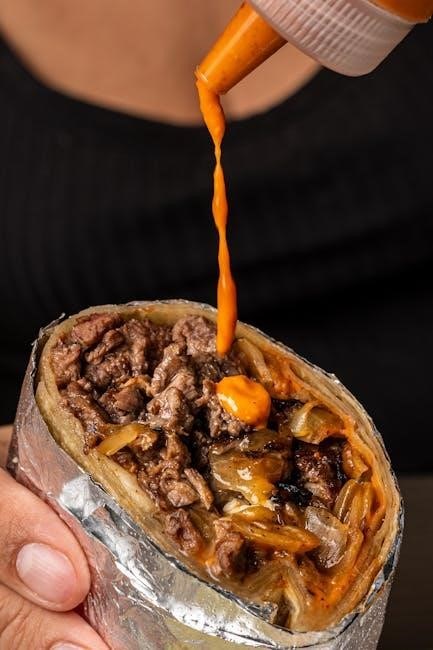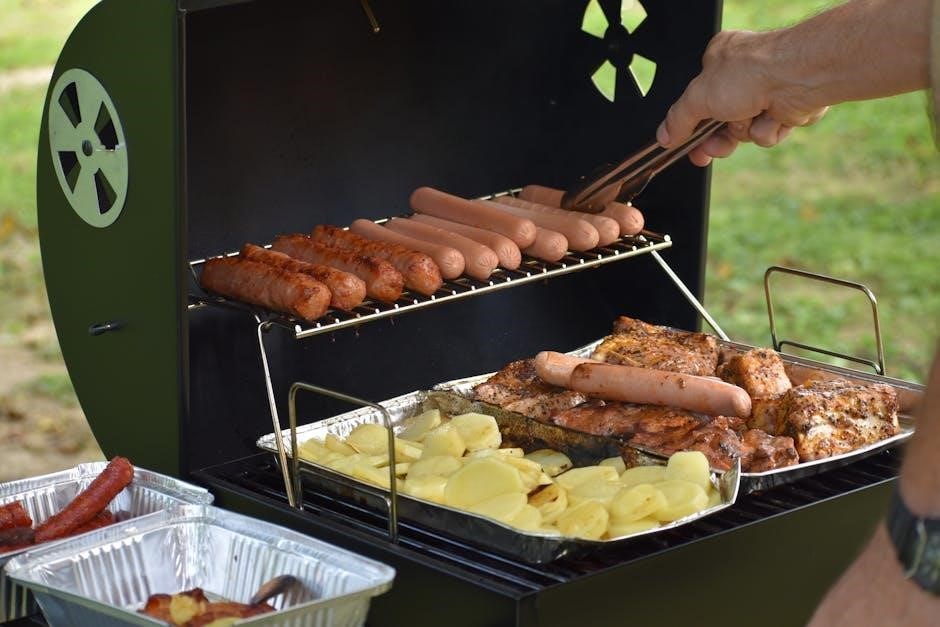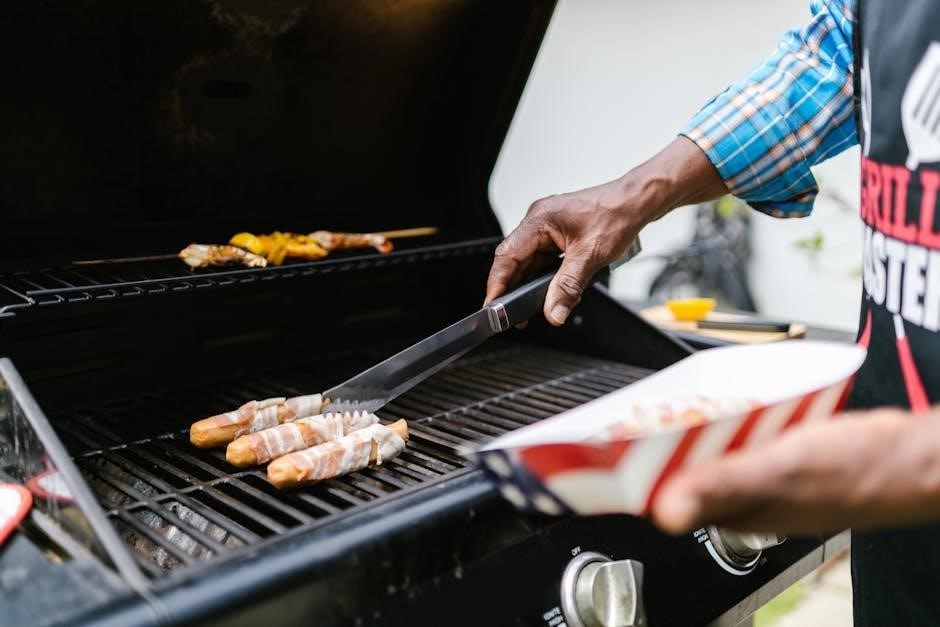Meat smoking is an art form that enhances flavor and texture through low-and-slow cooking, transforming simple cuts into rich, complex delicacies. This traditional method uses smoke to infuse deep, savory flavors into meats, creating tender and aromatic dishes. Perfect for beef, pork, chicken, and more, smoking is a versatile technique that delights both beginners and seasoned cooks alike.
1.1 What is Meat Smoking?
Meat smoking is a traditional cooking method that involves exposing meat to smoke from burning wood or charcoal at low temperatures. This slow process breaks down connective tissues, transforming tough cuts into tender, flavorful dishes. It enhances natural flavors and adds a rich, smoky aroma. Smoking requires patience but results in mouthwatering textures and bold, complex tastes, making it a beloved technique for both beginners and experienced cooks.
1.2 Benefits of Smoking Meat
Smoking meat offers numerous benefits, including enhanced flavor through natural smoke infusion, tenderization of tougher cuts, and preservation of moisture. It allows for versatile cooking with various meats like brisket, ribs, and chicken. Smoking also ensures food safety by cooking meats to safe internal temperatures. This method is ideal for creating bold, aromatic dishes that impress both casual diners and special occasion gatherings, making it a rewarding culinary technique.
Essential Equipment for Smoking Meat
Smoking meat requires essential equipment like smokers, wood, and tools. Various smoker types and accessories ensure perfect results, enhancing the smoking experience for enthusiasts.
2.1 Types of Smokers (Electric, Charcoal, Pellet, Offset)
Electric smokers offer ease of use and consistent results, while charcoal smokers provide an authentic, smoky flavor. Pellet smokers combine versatility with precise temperature control, ideal for both novices and pros. Offset smokers, with their large capacity, are perfect for cooking substantial quantities. Each type caters to different preferences, ensuring a tailored smoking experience for enthusiasts of all levels.
2.2 Must-Have Accessories (Meat Thermometer, Wood Chips, Grill Brushes)
A meat thermometer ensures accurate internal temperatures for food safety and perfect doneness. Wood chips add unique flavors, with options like hickory, oak, and apple. Grill brushes help clean grates and apply sauces. These essentials enhance the smoking process, making them indispensable for achieving tender, flavorful results. They are vital tools for both novice and experienced smokers to master their craft effectively.
Smoking Temperatures and Times
Smoking typically occurs between 200-220°F, with internal meat temperatures reaching 145°F for safety. This low-and-slow method ensures tender, flavorful results for meats like brisket, pork, and chicken.
3.1 Temperature Charts for Different Meats
Temperature charts are essential for smoking, ensuring meats reach safe internal temperatures. Beef brisket smokes at 225-250°F, reaching 145°F internally. Chicken thighs require 250-275°F, hitting 165°F. Pork shoulders smoke at 225-250°F, aiming for 190°F. Lamb legs need 225-250°F, reaching 145°F. These guidelines ensure tender, flavorful results while maintaining food safety. Referencing charts helps avoid undercooking or overcooking, guaranteeing perfectly smoked dishes every time.
3.2 Estimated Cooking Times for Popular Cuts
Popular cuts like brisket (10-12 hours at 225-250°F), pork shoulder (8-10 hours), and ribs (4-6 hours) require extended smoking times for tenderness. Chicken thighs smoke in 3-4 hours, while larger cuts like whole turkey or beef roasts may take 6-8 hours. Times vary based on size and smoker setup. Always use a meat thermometer for accuracy, ensuring a perfect, juicy finish every time.

Choosing the Right Meat for Smoking
Choosing the right meat for smoking is crucial for achieving tender, flavorful results. Opt for cuts with good fat content, like brisket or pork shoulder, as they stay juicy during long cooking times. Lean meats, such as chicken or turkey, also work well when brined or marinated. Always select fresh, high-quality cuts for the best outcomes.
4.1 Best Cuts of Beef, Pork, Chicken, and Lamb
For beef, brisket and short ribs are ideal for smoking due to their rich flavor and tender texture when cooked low and slow. Pork shoulder and baby back ribs are perfect for juicy, flavorful results. Chicken thighs or a whole chicken work well, while drumsticks are great for bites. Lamb leg, bone-in, is excellent for smoking, offering a robust, savory taste. These cuts stay juicy and absorb smoke flavors beautifully;
4.2 Tips for Selecting Fresh and Suitable Meat
Choose meats with good fat distribution for juiciness and flavor. Opt for fresh cuts with no signs of discoloration or unpleasant odors. For lamb, ensure it smells fresh and not gamey. Avoid overly lean meats, as they may dry out during smoking. Select cuts from reputable butchers or ranchers to ensure quality and freshness. Proper selection ensures a more flavorful and tender final product.
Preparing Meat for Smoking
Preparing meat for smoking involves methods like brining, dry brining, or using marinades and rubs to enhance flavor and texture, ensuring a juicy and delicious outcome.
5.1 Brining vs. Dry Brining: Which is Better?
Brining involves soaking meat in a saltwater solution to enhance moisture and flavor, while dry brining uses a dry rub to draw out moisture and concentrate natural flavors. Both methods ensure tender, flavorful results, but brining adds extra moisture, making it ideal for lean meats like poultry. Dry brining is simpler and suits meats with higher fat content, like pork or beef. Choose based on your preference and the meat type for optimal outcomes.
5.2 Marinades and Rubs for Enhanced Flavor
Marinades and rubs are essential for infusing rich flavors into meat before smoking. Marinades, often acidic, tenderize meat while adding moisture, while rubs enhance natural flavors with spices and seasonings. Apply marinades hours or days in advance, while rubs can be added just before smoking. Experiment with combinations to create unique flavor profiles, ensuring a delicious, aromatic smokehouse experience that complements the smoky undertones of your dish.

Setting Up Your Smoker
Arrange denser meats closer to the heat source and lighter meats further away for even cooking. Properly position wood and charcoal for optimal smoke distribution and temperature control.
6.1 Arranging Meat in the Smoker
Arrange meats thoughtfully to ensure even cooking. Place denser cuts like brisket or pork shoulder closer to the heat source, while lighter meats like chicken or fish go further away. This prevents overcooking and promotes uniform flavor distribution. Keep space between pieces for proper air circulation, enhancing smoke penetration. Proper arrangement ensures juicy, tender results and avoids drying out delicate cuts during the smoking process.
6.2 Using Wood and Charcoal for Optimal Smoke
Combining wood and charcoal creates rich, complex smoke flavors. Charcoal provides steady heat, while wood adds aromatic depth. Use hardwoods like hickory or oak for robust flavors, and fruitwoods like apple or cherry for sweeter notes. Soak wood chips in water to prevent flare-ups and ensure smooth smoke production. Maintain airflow to keep temperatures consistent, allowing the smoke to infuse evenly into the meat for a perfectly balanced flavor profile.
Smoking with Different Types of Wood
Smoking with various wood types enhances flavor profiles, as hickory adds robust notes, while apple and cherry provide sweeter, fruity undertones, perfect for infusing unique tastes into meats.
7.1 Popular Wood Varieties (Hickory, Oak, Apple, Cherry)
Hickory and oak are ideal for robust, smoky flavors, while apple and cherry woods offer sweeter, fruity notes. Hickory pairs perfectly with bacon and ribs, oak complements brisket, apple enhances poultry, and cherry infuses a mild sweetness into pork. Maple wood, though less common, adds a subtle, mild flavor. Each variety creates a unique profile, making wood selection a key factor in achieving desired taste in smoked meats.
7.2 Pairing Wood Flavors with Specific Meats
Hickory and oak woods are perfect for robust meats like brisket and ribs, enhancing their bold flavors. Apple and cherry woods complement poultry and pork, adding sweet, fruity notes. For delicate meats like fish, lighter woods such as maple or alder are ideal. Pairing the right wood with your meat ensures a balanced, complex flavor profile that elevates your smoking results to the next level.

Safety Tips for Smoking Meat
Always follow food safety guidelines to avoid contamination. Store smoked meat properly and consume within four days. Ensure meats reach safe internal temperatures during cooking.
8.1 Food Safety Guidelines
Ensuring food safety is crucial when smoking meat. Always cook meats to their recommended internal temperatures: 145°F for lamb, beef, and pork, and 165°F for poultry. Prevent cross-contamination by using separate utensils and surfaces for raw and cooked meat. Store smoked meat in shallow containers at 40°F or below within two hours of cooking. Consume within four days for optimal quality and safety.
- Avoid leaving smoked meat at room temperature for extended periods.
- Use a food thermometer to verify internal temperatures accurately.
- Keep raw and cooked meats separated during handling and storage.
8.2 Proper Storage and Handling of Smoked Meat
Proper storage is key to maintaining the quality of smoked meat; Cool it to room temperature within two hours, then refrigerate in shallow, airtight containers. Use within four days for optimal flavor. For longer storage, freeze in vacuum-sealed bags, ensuring no air exposure. Label and date all containers. When reheating, ensure meat reaches a safe internal temperature. Always check for signs of spoilage before consumption.
- Store in airtight containers to prevent drying and contamination.
- Keep refrigerated at 40°F or below to slow bacterial growth.
- Freeze for up to 6 months for extended preservation.

Troubleshooting Common Smoking Issues
Common smoking issues include overcooking, temperature fluctuations, and uneven smoke distribution. Monitor meat temperatures, adjust vents for airflow, and ensure wood levels are consistent for optimal results.
9.1 Avoiding Overcooking and Drying Out Meat
Avoid overcooking by using a meat thermometer to monitor internal temperatures. Maintain consistent smoker temperatures between 225-250°F for low-and-slow cooking. Wrap meat in foil during the later stages to retain moisture. Ensure adequate resting time after smoking to prevent drying. Regularly check meat thickness and adjust cooking times accordingly. Proper airflow and wood management also help prevent overcooking. Practice makes perfect in achieving tender, juicy results.
9.2 Managing Smoker Temperature Fluctuations
Maintain steady temperatures by ensuring proper airflow and using a meat thermometer. Close intake vents to lower temps and adjust wood/charcoal to prevent spikes. Monitor temperature every 30 minutes and adjust fuel as needed. Consistent fuel feeding helps stabilize heat. Avoid overheating by managing wood and charcoal intake carefully. Regular checks ensure optimal smoking conditions, preserving meat quality and flavor. Practice helps master temperature control for perfect results.


